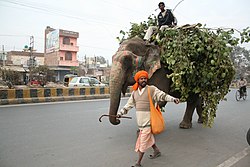Elephant in indian culture
Contents
Elephants in Indian culture
| Discussed species | Elephas maximus, Indian Elephant, हाथी |
|---|---|
| Distribution | Mainland Asia (India to Vietnam/Cambodia) and Sri Lanka. |
| IUCN Status | Endangered. In 2003, the wild population was estimated at between 41,410 and 52,345 individuals[1]. The population has declined by at least 50% over the last three generations, estimated to be 60–75 years[2] |
The Asian or Asiatic elephant (Elephas maximus) is the only living species of the genus Elephas and distributed in Southeast Asia from India in the west to Borneo in the east. Three subspecies are recognized — Elephas maximus maximus from Sri Lanka, the Indian elephant or E. m. indicus from mainland Asia, and E. m. sumatranus from the island of Sumatra. Asian elephants are the largest living land animals in Asia[3]. The species is pre-eminently threatened by habitat loss, degradation and fragmentation[2]. Elephants have also been hunted extensively in the past for their prized ivory tuskers.
Elephants assume a very special place in the religious as well as the day-to-day culture of Kerala. Kerala has more than seven hundred elephants in captivity. Most of them are owned by temples. While some elephants are used for religious ceremonies in and around the temples, a few also work at timber yards. Almost all of the festivals in Kerala include at least one richly decorated elephant. Elephants carry the deity during annual festival processions in the temples.These Indian elephants are loved, revered, groomed and given a prestigious place in the state's culture[4]. Many elephants are featured in the legends of the land. Aithihyamala (or a garland of historical anecdotes) by Kottarathil Sankunni was written in eight volumes; each volume ending with a story or legend about a famous elephant. For more about importance of elephants in Kerala culture, click here.
Elephants are important in Indian mythology too. Lord Ganesha - one of the most popular Indian deities and the Lord of Wisdom - bears an elephant head. The elephant head symbolizes great intellect and wisdom. The God of Gods Indra is believed to have a white elephant named Airavata as his vehicle. Elephants are also a symbol of royalty - Maharajas and kings used to ride during processions and in war on elephants. Megasthenes, the Greek ambassador to the court of Chandragupta Maurya reported the use of war elephants during warfare. The white elephant is also a religious symbol of the Buddha). The political party - the Bahujan Samaj Party - has an elephant as its election symbol.
In Islamic tradition, the year 570, when the Prophet Muhammad was born, is known as the Year of the Elephant. In that year, as recounted in the Muslim sources, Abraha, ruler of Yemen (most likely a viceroy for the Axumite Empire of Ethiopia), sought to conquer Mecca and demolish the Kaaba, reportedly in retaliation for the previous Meccan defilement of a cathedral Abraha had constructed in Sana'a. He launched an expedition of forty thousand men, led by a white elephant named Mahmoud (and possibly with other elephants - some accounts state there were several elephants, or even as many as eight)[5][6]). However, his design was foiled when Abraha's elephant reportedly refused to cross the boundary of Mecca and sat down. It could not be persuaded otherwise, either by reason or violence. The accounts state that if the elephant was turned towards Syria or Yemen it would walk without hesitation, but when it was turned towards the Kaaba it would kneel on its knees as if it would adore the city that its master was intent on destroying. "Al-Fil" ("The Elephant") - 105th Sura (chapter) of the Koran - commemorates this event with the verse: "Hast thou not observed how thy Lord dealt with the owners of the Elephant? Did He not bring their stratagem to nought?"
For more cultural depictions of elephants, see this page on Wikipedia
References
- ^ Sukumar, R. (2003). The Living Elephants: Evolutionary Ecology, Behavior, and Conservation. Oxford University Press, Oxford, UK.
- ^ a b Assessors=Choudhury, A., Lahiri Choudhury, D.K., Desai, A., Duckworth, J.W., Easa, P.S., Johnsingh, A.J.T., Fernando, P., Hedges, S., Gunawardena, M., Kurt, F., Karanth, U., Lister, A., Menon, V., Riddle, H., Rübel, A., Wikramanayake, E. (2008), version=2010.4
- ^ Shoshani, J, Eisenberg, J. F. (1982). "Elephas maximus". Mammalian Species 182: 1–8. doi:10.2307/3504045.
- ^ South India Handbook. Footprint Travel Guides, 2000. ISBN 1-900949-81-4. P.4
- ^ Hajjah Adil, Amina, "Prophet Muhammad", ISCA, Jun 1, 2002, ISBN 1-930409-11-7
- ^ William Montgomery Watt (1974), p.7
Comments
blog comments powered by DisqusMore notes like this
| |||||||||||||||||||||||||||||||||||||||||||||||||||||||||||||||||||||||||||||||||||||
Only 15 articles are shown in this list. A total of 64 articles in the database as of this moment. For the complete list, click on further results on the bottom right corner of the above table.
Semantic tags
- Browse all Semantic Tags associated with this page
- Find more pages and articles created by the community by clicking this link.
| Title | Elephant in indian culture | Article is on this general topic | Mythology and religion | Author | Gaurav Moghe |
|---|---|---|---|---|---|
| Specific location(s) where study was conducted | Not noted | General region where study was conducted | Not noted | State where study was conducted | Pan-India |
| Institutional affiliation | Not noted | Institution located at | Not noted | Institution based around | Not noted |
| Species Group | Mammals | User ID | User:Gauravm | Page creation date | 2011/10/15 |
Share this page:

